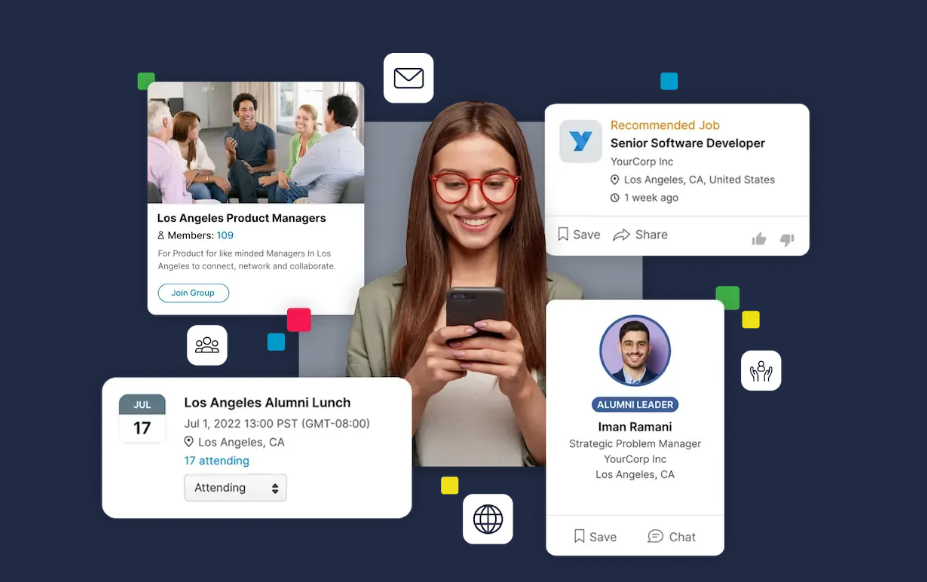Every time an employee leaves your organization, most companies treat it like the end of a relationship. Exit interviews happen, equipment gets returned, access badges are deactivated, and everyone moves on. But what if this traditional approach represents one of the biggest missed opportunities in modern business strategy?
Your former employees aren’t just people who used to work for you. They’re walking ambassadors who understand your culture intimately, maintain relationships with current staff, possess deep knowledge of your products and services, and often land in positions where they can become clients, partners, or sources of exceptional talent referrals. Yet most organizations let these valuable connections drift away after a farewell email and maybe an awkward LinkedIn endorsement.
The numbers tell a compelling story. Companies with active alumni programs report that former employees generate 20-30% of quality job referrals. In professional services firms, alumni connections account for significant new business opportunities. McKinsey, Deloitte, and other consultancies have known this for decades, which is why they’ve invested heavily in maintaining relationships with their alumni networks. The return on investment isn’t just measurable; it’s substantial.
But here’s what’s changed: what was once the exclusive domain of elite consulting firms and top-tier universities has become accessible to organizations of all sizes. The technology, strategies, and best practices for building thriving alumni communities are now available to any forward-thinking company willing to invest in these relationships. The question isn’t whether alumni networks provide value anymore. It’s whether your organization will capture that value or watch competitors do it instead.

The Strategic Case for Corporate Alumni Programs
The traditional employer-employee relationship ended the moment someone gave notice. Today’s most innovative companies recognize that this transactional mindset leaves enormous value on the table. Your alumni represent a strategic asset that compounds in value over time, yet most organizations treat them as sunk costs rather than ongoing investments.
Consider the recruitment advantage alone. The cost of hiring a new employee ranges from $4,000 to over $20,000 depending on the role and industry. A significant portion of that expense goes toward sourcing candidates, screening resumes, and conducting interviews with people who may or may not fit your culture. Your alumni already understand your culture deeply. They know what it takes to succeed in your environment. When they refer candidates from their networks, those referrals come with implicit endorsement and cultural pre-screening that dramatically improves hiring outcomes.
The boomerang phenomenon has grown substantially over the past decade. Studies show that “boomerang employees” who return to previous employers often perform at higher levels than new external hires. They require less onboarding, already understand internal systems and processes, and typically demonstrate greater loyalty the second time around. Companies with robust alumni programs report that 10-15% of their hires are former employees returning with valuable experience gained elsewhere.
Business development opportunities through alumni networks often exceed recruitment benefits. Your former employees move into client organizations, become decision-makers at potential partners, or start their own companies. These alumni understand your capabilities and can advocate internally in ways that cold outreach never achieves. In B2B contexts especially, having alumni embedded in prospect organizations creates relationship capital that competitors struggle to replicate.
Brand advocacy extends your employer brand reach exponentially without advertising spend. When former employees speak positively about their experience at your organization, it carries authenticity that no corporate messaging can match. They provide honest testimonials about company culture, growth opportunities, and leadership quality that prospective employees trust implicitly. This organic advocacy becomes increasingly valuable as employer review sites and social media amplify individual voices.
The knowledge and market intelligence your alumni possess about competitors, emerging trends, and industry dynamics provides strategic value that’s difficult to quantify but impossible to ignore. Alumni in competitor organizations, emerging markets, or adjacent sectors offer perspectives that help you understand market movements before they become obvious to everyone else. This intelligence flow works both ways, with current employees learning from alumni experiences in different contexts.

Building Alumni Programs That Actually Work
Understanding the value of alumni networks and actually capturing that value are two very different challenges. Many organizations launch alumni initiatives with enthusiasm only to watch them wither into inactive databases and occasional newsletters that nobody reads. The difference between thriving alumni communities and failed experiments comes down to intentional design, appropriate technology infrastructure, and sustained commitment.
Successful alumni programs start with clear strategic objectives. What specific business outcomes should your alumni network drive? Some organizations prioritize recruitment and talent pipelines. Others focus on business development and client relationships. Many pursue multiple objectives simultaneously, recognizing that alumni can contribute value through various channels. Defining these goals upfront ensures you measure the right outcomes and design engagement activities that actually move the needle on metrics that matter to your business.
Technology infrastructure makes or breaks alumni engagement. Trying to maintain alumni relationships through scattered spreadsheets, generic email lists, or repurposed employee systems simply doesn’t work at scale. Alumni need dedicated platforms designed specifically for this purpose, with features like searchable member directories, targeted communication capabilities, event management, job boards, and networking tools that keep former employees connected to each other and to your organization.
The best platforms handle the operational complexity of alumni management while providing experiences that alumni actually want to engage with. This includes self-service profile management where alumni update their own information, sophisticated segmentation for relevant communications, private networking capabilities that respect privacy, and integration with existing HR systems to seamlessly transition departing employees into alumni status.
Organizations serious about building strategic alumni programs increasingly turn to purpose-built solutions that understand the unique requirements of corporate alumni engagement. The EnterpriseAlumni trusted alumni platform exemplifies modern approaches to alumni management, providing comprehensive features that transform former employee relationships from administrative afterthoughts into strategic assets. These dedicated platforms recognize that effective alumni programs require more than basic contact management; they need robust engagement tools, analytics to measure program impact, and scalable infrastructure that grows with your alumni population.
What separates leading solutions is their focus specifically on corporate alumni needs rather than trying to adapt systems built for other purposes. The feature sets, user experiences, and integration capabilities reflect deep understanding of how companies actually want to engage alumni and what outcomes they’re trying to achieve. This specialization matters because generic tools inevitably miss the nuances that make alumni programs succeed or fail.

Creating Consistent Value for Alumni Members
The most common mistake organizations make with alumni programs is treating them as one-way extraction mechanisms. Companies reach out when they need referrals, want to recruit someone back, or are looking for client introductions, but provide little ongoing value to alumni themselves. This transactional approach creates resentment and disengagement.
Thriving alumni communities operate on reciprocity. Alumni engage because they receive genuine ongoing benefits, not just because they might help their former employer someday. These benefits take various forms: professional development content that helps alumni in current roles, networking opportunities with other accomplished alumni, exclusive events that provide social connection, career resources including job boards and coaching, and insider access to company developments before they’re public.
Content strategy for alumni engagement requires balancing organizational updates with resources that serve alumni interests. Yes, alumni care about company news, especially major announcements or leadership changes. But they also need content that helps them navigate their current careers: industry insights, skill development resources, leadership advice, and thought leadership that positions them well in their networks. Providing this ongoing value keeps alumni engaged and creates reciprocal goodwill.
Networking facilitation represents one of the most valuable services alumni programs can provide. Many alumni maintain strong relationships with former colleagues but lose touch with the broader community. Programs that facilitate connections based on shared interests, industries, locations, or roles create value that extends far beyond any individual organization. When alumni help each other succeed through network introductions, knowledge sharing, or collaboration opportunities, the organization that enabled those connections earns lasting gratitude.
Events remain crucial for alumni engagement despite digital tools that enable virtual connection. Regional gatherings, industry-specific meetups, and annual reunions provide face-to-face interaction that deepens relationships in ways online platforms cannot replicate. The most effective programs offer both regular virtual engagement and periodic in-person events that cater to different preferences and geographic realities.
Recognition programs that celebrate alumni achievements reinforce positive associations with your organization. Highlighting alumni who’ve accomplished notable things, reached career milestones, or contributed significantly to communities signals that you continue caring about their success beyond their employment. This recognition costs nothing but generates goodwill and keeps successful alumni emotionally connected to your organization.

Measuring Alumni Program Success
Organizations investing in alumni programs need clear metrics to justify continued investment and optimize their approaches. Unlike many soft HR initiatives, alumni programs offer multiple quantifiable outcomes that demonstrate business value.
Recruitment metrics provide the most direct ROI measurements. Track the number of positions filled through alumni referrals, time-to-fill for those roles compared to other sources, quality of hire scores, and retention rates. Many organizations discover that alumni-referred candidates have significantly lower cost-per-hire, faster time-to-productivity, and higher retention than candidates sourced through other channels. These differences directly translate to substantial cost savings that justify alumni program investments.
Boomerang hire rates measure how many former employees return and how their performance compares to external hires. Organizations should track not just the number of returning employees but their tenure, performance ratings, and progression after returning. The data consistently shows that boomerang employees often become top performers who contribute disproportionately to organizational success.
Business development impact tracks revenue influenced by alumni connections. This includes new clients introduced by alumni, partnerships facilitated through alumni networks, and deals where alumni advocacy played roles in closing. While attribution can be complex, even approximate tracking demonstrates tangible business value from maintaining alumni relationships.
Engagement metrics reveal whether your alumni program is actually functioning as a community or existing only on paper. Active user counts on your platform, event attendance rates, response rates to communications, and networking activity all indicate community health. High engagement correlates with the network’s ability to deliver value when you have specific needs like urgent hiring or client introductions.
Brand advocacy measurements including employer review site ratings, social media sentiment, and referral program participation show how alumni speak about your organization. Organizations with strong alumni programs consistently see better employer brand metrics because satisfied former employees become voluntary brand ambassadors.
The sophistication of Alumni platform software by EnterpriseAlumni and similar solutions enables tracking these metrics systematically rather than relying on anecdotal evidence. Built-in analytics show which engagement activities drive outcomes, which alumni segments are most active, and how program activities correlate with business results. This data-driven approach allows continuous improvement based on actual performance rather than assumptions about what alumni want or need.

Implementation Best Practices From Leading Organizations
Companies that successfully launch and maintain thriving alumni programs share common approaches worth emulating. These best practices emerge from years of experimentation and refinement across industries and organization sizes.
Executive sponsorship matters enormously. Alumni programs need visible support from senior leadership to succeed. When executives actively participate in alumni events, reference the alumni community in public communications, and include alumni outcomes in strategic reviews, it signals organizational commitment that enables resource allocation and cross-functional cooperation. Without this top-down support, alumni programs often become orphaned HR initiatives that struggle for attention and budget.
Cross-functional governance ensures alumni programs serve multiple stakeholders. The most effective programs have steering committees including representatives from HR, recruiting, marketing, business development, and sometimes product or sales. This diverse perspective prevents programs from optimizing for single functions while missing broader opportunities. When recruiting, marketing, and business development all see value from the alumni network, they collectively advocate for appropriate investment.
Transition processes for departing employees set the tone for ongoing relationships. Organizations with strong alumni programs treat departures as transitions rather than endings. Exit processes include information about the alumni network, how to stay connected, and what resources will be available. Some companies even host small farewell gatherings that celebrate contributions and frame the departure positively. These thoughtful transitions dramatically increase the likelihood of maintaining positive relationships.
Segmentation strategies allow relevant engagement at scale. Alumni populations are inherently diverse, spanning different eras, functions, seniority levels, industries, and geographies. Programs that try to engage everyone identically quickly become noise that people tune out. Effective segmentation enables targeted communications and opportunities based on factors like location (for regional events), industry (for sector-specific networking), tenure (distinguishing recent departures from long-ago alumni), and interests.
Regular communication calendars maintain engagement without overwhelming people. The best programs establish rhythm through monthly newsletters, quarterly virtual events, semi-annual in-person gatherings, and ad hoc communications about timely opportunities. This consistent presence keeps the network active without bombarding alumni with so many messages that they disengage.
Read More: Employee Monitoring Software: Myths vs. Reality
Your Alumni Network Awaits
The opportunity to transform former employees into strategic assets sits waiting for organizations willing to invest in the relationships, technology, and processes that make alumni programs successful. The economics are compelling: recruitment cost savings alone often justify alumni program investments, with business development and brand advantages providing additional returns.
What separates winners from those who let this opportunity pass is recognition that alumni programs require intentional strategy and appropriate infrastructure. Scattered spreadsheets and occasional emails don’t create the engagement needed for programs to deliver value. Purpose-built platforms, clear governance, executive sponsorship, and sustained commitment to providing value to alumni are what separate programs that thrive from those that wither.
The former employees who’ve moved on to other opportunities represent potential that compounds over time. They gain experience, build networks, advance into positions of influence, and accumulate knowledge that benefits everyone connected to them. By maintaining positive relationships and facilitating ongoing connection, you ensure that when opportunities arise, your organization benefits from the success of everyone who’s ever been part of your team.
Your alumni network is waiting. The question is whether you’ll activate it before your competitors do.




